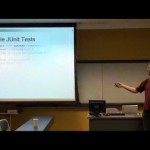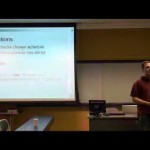In order to understand future examples, we first have to discuss how to use higher-order functions in Java, and how to write anonymous inner classes. This post will have nothing to do with multi-stage programming.
Let’s write a program that can print out data tables for different mathematical functions. For example, for a function that multiplies by two, f(x) = 2x, we want to print something like this:
x f(x)
-5.0000000000 -10.0000000000
-4.0000000000 -8.0000000000
-3.0000000000 -6.0000000000
-2.0000000000 -4.0000000000
-1.0000000000 -2.0000000000
0.0000000000 0.0000000000
1.0000000000 2.0000000000
2.0000000000 4.0000000000
3.0000000000 6.0000000000
4.0000000000 8.0000000000
5.0000000000 10.0000000000
We can write a function like this:
public static void printTableTimesTwo(double x1,
double x2,
int n) {
assert n>1;
double x = x1;
double delta = (x2-x1)/(double)(n-1);
System.out.println("x f(x)");
System.out.printf("%20.10f %20.10f\n", x, x*2);
for(int i=0; i<(n-1); ++i) {
x += delta;
System.out.printf("%20.10f %20.10f\n", x, x*2);
}
}
The parameter x1 determines the lower end of the interval, x2 the upper end, and n determines how many values should be printed. n needs to be at least 2 to print out the values at x1 and x2. We can generate the table above with this call:
printTableTimesTwo(-5, 5, 11);
What if we want to print out the values of a different function, for example f(x) = x + 4? We can write a new function:
public static void printTablePlusFour(double x1,
double x2,
int n) {
assert n>1;
double x = x1;
double delta = (x2-x1)/(double)(n-1);
System.out.println("x f(x)");
System.out.printf("%20.10f %20.10f\n", x, x+4);
for(int i=0; i<(n-1); ++i) {
x += delta;
System.out.printf("%20.10f %20.10f\n", x, x+4);
}
}
This involves a lot of code duplication, though. The only parts that actually differ are the two occurrences of x*2 and x+4. How can we factor that difference out?
Let's write an interface that we can use for any kind of function that takes in one parameter and returns one parameter f(x) = y is an example of such a function.
public interface ILambda; {
public R apply(P param);
}
This interface is called ILambda and it has one method, apply. We used Java generics and didn't specify the return type and the type of the parameter; instead, we just called them R and P, respectively. A function that takes in a Double and that returns a Double, like f(x) = y, can be expressed using a ILambda. A function taking a String and returning an Integer would use ILambda.
Now we can write our f(x) = 2x and f(x) = x + 4 functions using ILambda:
public class TimesTwo implements ILambda {
public Double apply(Double param) { return param*2; }
}
public class PlusFour implements ILambda {
public Double apply(Double param) { return param+4; }
}
Now we can write one printTable method that takes in an ILambda called f representing the function, in addition to the parameters x1, x2 and n, as before:
public static void printTable(ILambda f,
double x1,
double x2,
int n) {
assert n>1;
double x = x1;
double delta = (x2-x1)/(double)(n-1);
// f.apply(x) just means what f(x) means in math!
double y = f.apply(x);
System.out.println("x f(x)");
System.out.printf("%20.10f %20.10f\n", x, y);
for(int i=0; i<(n-1); ++i) {
x += delta;
y = f.apply(x);
System.out.printf("%20.10f %20.10f\n", x, y);
}
}
Note that when we want to print out the y-value, we just write f.apply(x), which looks very similar to f(x) in mathematics. It means exactly the same.
We can print out the tables for our two functions using:
printTable(new TimesTwo(), -5, 5, 11);
printTable(new PlusFour(), -5, 5, 11);
We have to create new objects for the functions: The first time we call printTable we pass a new TimesTwo object; the second time, we pass a new PlusFour object.
We can now define as many functions as we like without having to rewrite the printTable function. For example, we can easily write a square root function and use it very easily:
public class SquareRoot implements ILambda {
public Double apply(Double param) {
return Math.sqrt(param);
}
}
// ...
printTable(new SquareRoot(), -5, 5, 11);
The really neat thing is that we can even define a new function on-the-fly, without having to give it a name. We do that using anonymous inner classes in Java. Here, we call printTable and pass it a new object that implements ILambda.
printTable(new ILambda() {
public Double apply(Double param) {
return param*param;
}
}, -5, 5, 11);
We define a new ILambda from Double to Double without giving it a name. When we use anonymous inner classes, we need to fill in all the methods that are still abstract. Here, it is just the apply method.
The method printTable is now a "higher order function", because conceptually it is a function that takes another function as input.
Questions:
- What does the anonymous
ILambda in the example above compute? What's the mathematical function it represents?
- How would you print a table for the function f(x) = x2 + 2x?
You can download the complete source code for the examples here:
(Re-posted from The Java Mint Blog)







